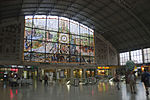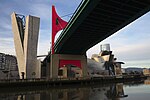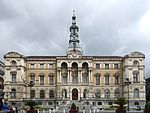Isozaki Atea

The Isozaki Atea (Basque: Isozaki Gate) twin towers in Bilbao, Spain are the tallest residential buildings in the city and the Basque Country, designed by Japanese architect Arata Isozaki. The towers are 83 metres (272 ft) tall and have 23 floors. The first two floors are used for mixed-commercial purposes, and the remaining floors are residential. The towers are part of a five-building complex. The other three buildings' heights range between six and eight floors."Atea" means "gate" in Basque; the complex is intended as the entrance to the Ensanche of the city from the other side of the Nervión river as a footway directly connects the staircase between the two towers to the Zubizuri footbridge. The staircase leads to Ercilla Street.
Excerpt from the Wikipedia article Isozaki Atea (License: CC BY-SA 3.0, Authors, Images).Isozaki Atea
Bizikidetasun plaza / Plaza de la Convivencia, Bilbao Abando
Geographical coordinates (GPS) Address External links Nearby Places Show on map
Geographical coordinates (GPS)
| Latitude | Longitude |
|---|---|
| N 43.265833333333 ° | E -2.9288888888889 ° |
Address
Isozaki Atea
Bizikidetasun plaza / Plaza de la Convivencia
48071 Bilbao, Abando
Autonomous Community of the Basque Country, Spain
Open on Google Maps










